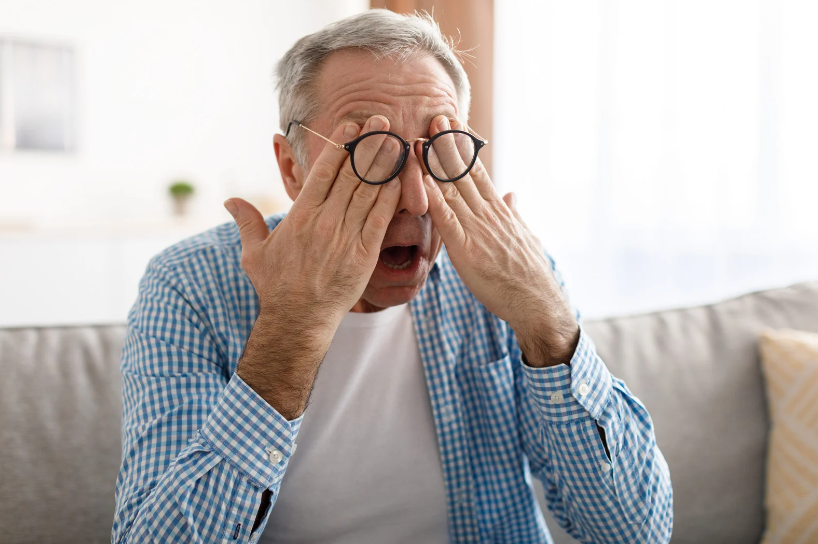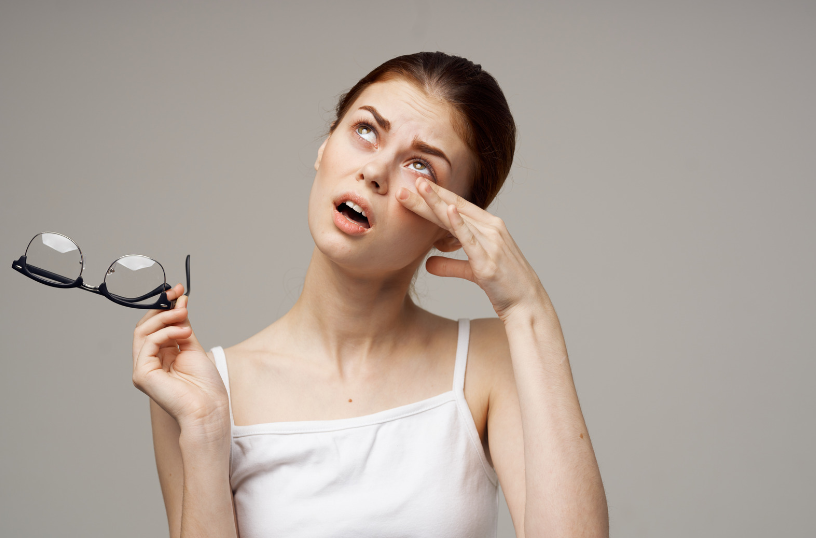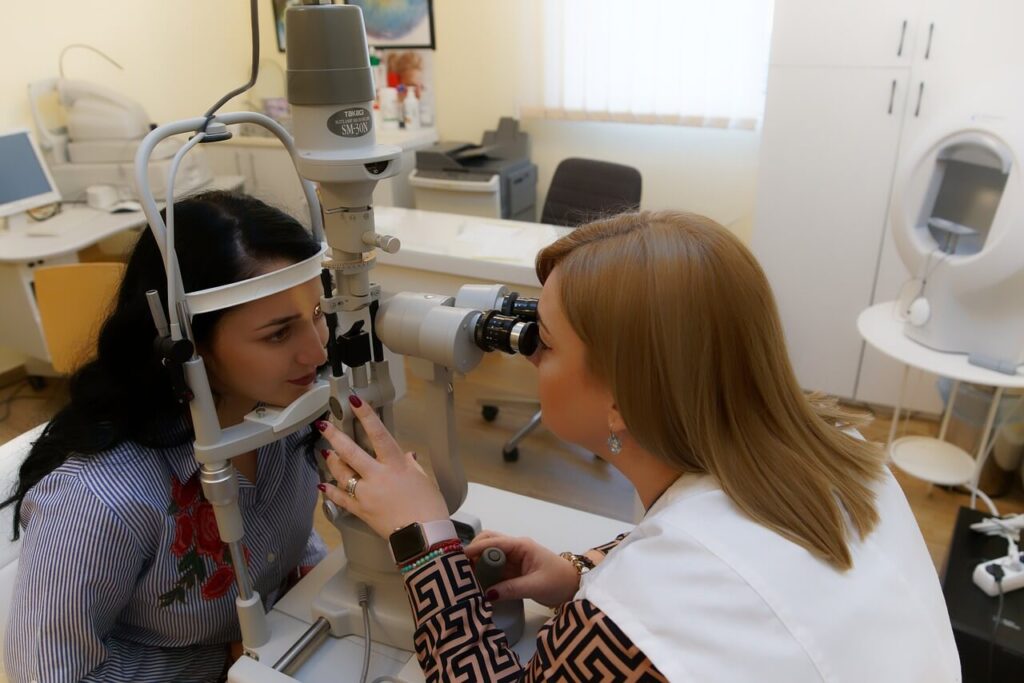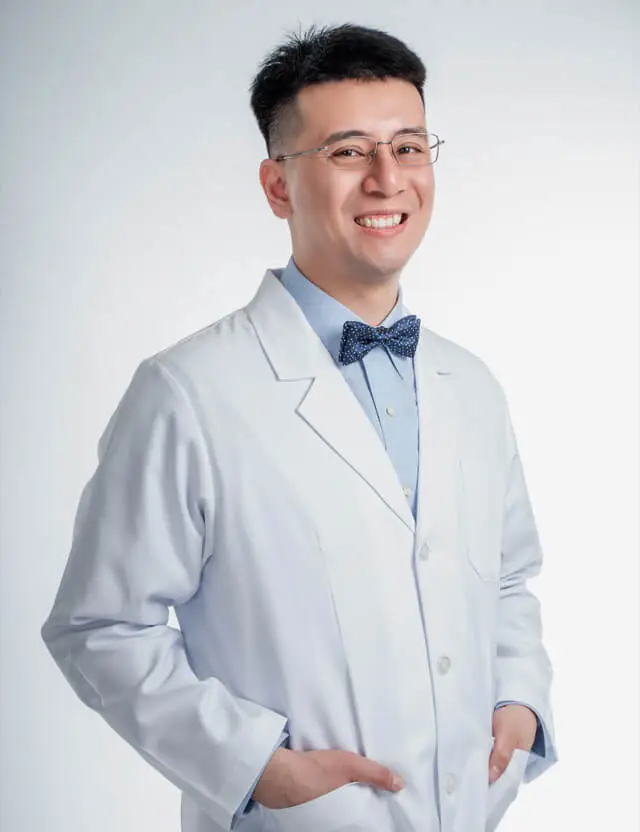Bad eyesight can be inherited, and it is more likely if one or both of your parents have eye problems. Other factors that might contribute to poor eyesight include environment, lifestyle, nutrition, and others.
Understanding the genetic basis of eye conditions can help in early diagnosis and management, potentially reducing the severity of the condition.
Is Bad Eyesight Genetic?
Whether bad eyesight is inherited is complicated. Many eye diseases are caused by genetics, but environmental and lifestyle factors can have an influence on eye health.
According to a recent study, more than 200 genes are connected with refractive defects such as myopia and hyperopia, highlighting the hereditary component of these disorders.
Bad eyesight is not easily classified as dominant or recessive, yet it typically runs in families. However, genetics alone cannot entirely explain impaired eyesight.
Genetic characteristics can be dominant or recessive, indicating how they are passed down from parents to children. Dominant qualities may be exhibited with only one copy of the gene from either parent, but recessive traits require two copies, one from each parent.
If a parent has a dominant gene for an eye condition, their kid is 50% (higher chance) likely to inherit it. Recessive features require both parents to pass on the gene in order for their kid to acquire the condition, which typically occurs more commonly in families owing to similar genetic origins.
Hereditary Eye Conditions

1. Genetic mutations
Genetic mutations can result in a number of ocular problems. Mutations in certain genes involved in eye development and function can cause hereditary eye disorders. For example, mutations in the RHO, USH2A, and EYS genes have been linked to retinitis pigmentosa, a disorder that causes progressive vision problems and degenerative disease.
2. Age-related macular degeneration (AMD)
AMD is the major cause of visual loss among older persons. While age is the biggest risk factor, genetics also play an important influence. Several genes have been lifnked to an increased risk of AMD, including CFH, ARMS2, and HTRA1.
According to research, those with a family history of AMD are 50% more likely to get the illness themselves. AMD is characterized by blurred vision and is influenced by refractive errors.
3. Glaucoma
Glaucoma, a group of eye disorders that affect the optic nerve, frequently has a genetic component. Mutations in the MYOC and OPTN genes have been associated to the most frequent kind of glaucoma, primary open-angle. Family history considerably increases the likelihood of getting this illness.
A research discovered that those who have a first-degree relative with glaucoma are 10 times more likely to get the condition.
4. Cataracts
Cataracts, which cause clouding of the eye’s lens, can be inherited. While cataracts are generally caused by aging, hereditary factors can predispose people to get them early. According to the World Health Organization, cataracts account for 51% of global blindness, highlighting the need of understanding both hereditary and environmental factors. Symptoms of cataracts include blurry vision, necessitating consultation with an eye doctor.
5. Retinitis pigmentosa
Retinitis pigmentosa (RP) is a collection of hereditary illnesses that cause retinal degeneration. It is extremely inherited, with over 50 distinct genes associated with the illness. RP usually starts with night blindness and develops to peripheral vision loss. According to the Foundation Fighting Blindness, RP affects around one in every 4,000 persons globally, leading to vision impairments in those affected.
6. Myopia (nearsightedness)
Myopia is a common refractive defect that makes distant things look fuzzy.
According to recent research, if both of your parents have myopia (shortsightedness), you have a 1 in 3 probability of being myopic as well. If just one parent has myopia, the probability drops to 1 in 5.
However, your chances of being myopic are at most 1 in 40 if neither of your parents is. Genes affect our genetic predisposition to short sightedness, even if our surroundings and way of life also impact us. In this blog, we will know if normal vision is poor eyesight genetic.
Myopia is becoming more common over the world, with predictions indicating that by 2050, nearly half of the worldwide population would be myopic, showing how the condition affects global populations.
7. Hyperopia (farsightedness)
Another one of the common eye problems is hyperopia, often known as farsightedness. While less is known about its genetic foundation than myopia, research indicates an inherited component.
Variations in genes involved in eye development can affect hyperopia risk, contributing to vision problems. The frequency of hyperopia varies with age and ethnicity, with considerable inherited genetic markers observed in different cultures, influencing refractive error.
8. Color blindness
Color blindness is frequently inherited, particularly the red-green variant, which is connected to the X chromosome. This explains why guys with only one X chromosome are more commonly afflicted.
Mutations in the OPN1LW and OPN1MW genes are the cause of red-green color blindness. Color blindness affects around 8% of men and 0.5% of women of Northern European heritage, affecting central vision.
9. Strabismus
Strabismus, often known as eye misalignment, can be inherited. Genetic factors affect the development of the eye muscles and nerves, which contributes to the disorder. According to research published in the Journal of the American Association for Pediatric Ophthalmology and Strabismus, genetics account for 30-60% of cases, influencing vision problems and central vision. Whole family history can heavily influence the prevalence of strabismus.
10. Optic atrophy
Optic atrophy is the deterioration of the optic nerve, which causes vision loss. These mutations disrupt mitochondrial function, which is critical for nerve cell survival. Hereditary ocular neuropathies, such as Leber’s hereditary optic neuropathy, are common genetic causes of optic atrophy, affecting retinal cells.
It is important to remember that having a family history of these conditions does not guarantee that one will develop them.
Regular eye exams with an ophthalmologist can help to detect any potential issues early on and allow for appropriate management and treatment.
Factors That Can Cause Poor Vision
Environmental factors play a significant role in affecting eyesight and overall eye health. Here are some key environmental factors and how they can impact vision:
1. UV Radiation
- Exposure to UV Rays: Prolonged exposure to ultraviolet (UV) rays from the sun can lead to eyesight problems such as cataracts, macular degeneration, and photokeratitis (sunburn of the cornea).
- Protection: Wearing sunglasses with UV protection and wide-brimmed hats can help shield eyes from harmful UV rays.
2. Digital Screen Exposure

- Digital Eye Strain: Prolonged use of computers, smartphones, and other digital devices can cause and heavily influenced eye strain, dryness, and discomfort, often referred to as Computer Vision Syndrome (CVS).
- Protection: Following the 20-20-20 rule (taking a 20-second break every 20 minutes to look at something 20 feet away), using blue light filters, and maintaining proper screen distance can help reduce strain.
3. Air Quality
- Pollution and Irritants: Exposure to pollutants, smoke, and chemicals can irritate the eyes, leading to dryness, redness, and allergic reactions.
- Protection: Using air purifiers, avoiding smoky or polluted environments, and wearing protective eyewear in high-risk areas can help.
4. Dry Air
- Low Humidity: Environments with low humidity, such as air-conditioned rooms or heated spaces in winter, can cause dry eyes by reducing the moisture on the eye’s surface.
- Protection: Using a humidifier, staying hydrated, and using artificial tears can alleviate dryness.
5. Occupational Hazards
- Workplace Risks: Certain jobs expose individuals to eye hazards like dust, debris, chemicals, and bright lights, increasing the risk of eye injuries and strain.
- Protection: Wearing appropriate safety goggles, taking regular breaks, and following workplace safety guidelines are essential.
6. Lighting Conditions
- Poor Lighting: Working or reading in poor lighting conditions can strain the eyes and lead to discomfort.
- Protection: Ensuring adequate lighting, avoiding glare, and adjusting screen brightness can help reduce eye strain.
7. Allergens

- Seasonal Allergens: Pollen, dust mites, pet dander, and other allergens can cause eye allergies, leading to itching, redness, and watering.
- Protection: Keeping windows closed during high pollen seasons, using air filters, and using antihistamine eye drops can provide relief.
8. Nutrition and Hydration
- A diet lacking essential nutrients like vitamins A, C, E, and omega-3 fatty acids can affect eye health and increase the risk of conditions like macular degeneration, diabetic retinopathy, and dry eyes.
- Hydration: Staying hydrated is important to maintain the moisture levels in the eyes.
9. Smoking
- Tobacco Smoke: Smoking and exposure to secondhand smoke can contribute to the development of cataracts, macular degeneration, and dry eye syndrome.
- Protection: Quitting smoking and avoiding exposure to tobacco smoke can significantly benefit eye health.
10. Sleep
- Lack of Sleep: Insufficient sleep can lead to eye strain, dryness, and twitching.
- Protection: Ensuring adequate, restful sleep each night helps maintain overall eye health.
11. Physical Activity and Eye Safety
- Sports and Activities: Engaging in sports without proper eye protection can lead to injuries.
- Protection: Wearing appropriate protective eyewear during sports and recreational activities can prevent injuries.
Is Bad Vision Genetic?
Many eye disorders are inherited. Genetic mutations are directly associated with conditions such as retinitis pigmentosa, colorblindness, and congenital cataracts. Even common refractive problems such as myopia and hyperopia are genetic. However, the interplay of environmental and genetic factors frequently affects the overall risk and course of many diseases.
Treatments for Poor Eyesight

Treatments for most common vision problems differ based on the underlying problem and severity. These therapies include corrective lenses, surgical operations, and lifestyle changes.
1. Corrective Lenses
Glasses are the most prevalent type of vision correction. They can treat refractive defects such as myopia (nearsightedness), hyperopia (farsightedness), astigmatism, and presbyopia (age-related difficulties concentrating on nearby objects). Modern eyeglasses are available in a range of shapes and materials, and they provide not just vision correction but also UV protection and digital screen glare reduction, addressing light sensitivity.
2. LASIK
Laser-Assisted In Situ Keratomileusis (LASIK) is a popular surgical method for treating myopia, hyperopia, and astigmatism. LASIK reshapes the cornea to allow light entering the eye to be correctly focused on the retina, resulting in improved vision. The operation has a high success rate, with the American Society of Cataract and Refractive Surgery claiming that more than 95% of patients have 20/40 vision or better after surgery, addressing tunnel vision.
3. PRK
Another form of laser eye surgery is photorefractive keratectomy (PRK), which involves reshaping the cornea to treat refractive defects. Unlike LASIK, PRK does not form a flap in the cornea. Instead, it eliminates the cornea’s outer layer, which eventually regenerates. PRK is commonly advised for individuals with thin corneas or dry eyes.
4. Eye Drops
Prescription eye drops are often used to treat glaucoma and dry eye syndrome. Eye drops for glaucoma assist lower intraocular pressure by either reducing fluid production or boosting fluid outflow in the eye. Lubricating eye drops, commonly known as artificial tears, aid in the maintenance of moisture on the eye’s surface.
5. Oral Medications
In rare situations, prescription medications may be used to treat eye disorders. For example, oral carbonic anhydrase inhibitors can be administered in conjunction with eye drops to reduce ocular pressure in glaucoma patients. Oral antibiotics or anti-inflammatory medicines may be recommended to treat eye infections or inflammation.
6. Diet & Nutrition
A vitamin and mineral-rich diet is vital for keeping your eyes healthy. Nutrients that are important for eye health include vitamins A, C, and E, as well as zinc, lutein, and omega-3 fatty acids. Leafy vegetables, carrots, salmon, and almonds are all good for your eyesight. According to the Age-Related Eye Disease Study (AREDS), certain dietary supplements can help reduce the progression of AMD.
7. Quit Smoking

Smoking is a significant risk factor for a variety of eye disorders, including cataracts, AMD, and dry eye syndrome. Quitting smoking can dramatically lower the likelihood of developing these problems while also improving general eye health. The American Lung Association offers materials and help to people who want to quit smoking.
8. Regular Eye Exams
Regular eye exams are essential for the early diagnosis and treatment of eye disorders. An eye care specialist can track visual changes, spot problems early, and offer suitable treatments. The Centers for illness Control and Prevention (CDC) recommends an annual comprehensive eye exam, especially for people who have a family history of eye issues or are at increased risk for eye illness.
Frequently Asked Questions
Is Bad Eyesight Genetic or Environmental?
Poor vision can be caused by both inherited and environmental causes. While many eye diseases are genetic, lifestyle decisions and environmental exposures can have a substantial impact on vision health.
Does Eyesight Come from Mom or Dad?
Inherited eye disorders vary in their genetic patterns. For instance, X-linked conditions like color blindness often originate from genetic traits passed down through the mother
What Causes Bad Eyesight at a Young Age?
Bad vision at a young age can be caused by genetics, developmental difficulties, or environmental factors such as excessive screen usage or bad lighting conditions. Myopia and strabismus are common conditions that appear in infancy.
Is Bad Eyesight a Disability?
Bad vision is considered an impairment if it considerably limits an individual’s ability to conduct daily tasks. Conditions such as severe myopia, retinitis pigmentosa, and progressive glaucoma can result in vision impairment or blindness, which qualify as impairments.
Takeaway
Bad eyesight can indeed be hereditary, with many eye conditions linked to genetic factors. However, environmental factors and lifestyle decisions can play a role in eye health as well. Understanding the interaction between genes and the environment can aid in the prevention, management, and treatment of impaired eyesight.
You may maintain superior vision and general eye health by taking proactive efforts to safeguard your eyes and scheduling annual or frequent eye test. If you have a family history of eye issues, you should be extra cautious and consider genetic testing and visit with an eye care specialist for specialized advice and treatment choices. Additionally, factors like high blood pressure can impact eye health and should be managed effectively.
Po-Chang Hsu, M.D., received his medical doctorate from Tufts University School of Medicine in Boston. During his medical school training, Dr. Hsu worked with various patients, including adult and pediatric patients with acute and chronic conditions. Dr. Hsu’s interests include neurology, psychiatry, pediatrics, and sleep medicine.
Before medical school, Dr. Hsu finished a master’s degree at Harvard University and wrote a thesis on neuroimaging in schizophrenia patients at Brigham and Women’s Hospital, a Harvard Medical School-affiliated hospital. Dr. Hsu was also a part of the 2008 NASA Phoenix Lander Mission team, which sent a robotic spacecraft to the North polar region of Mars. Dr. Hsu also had research experience on neuroimaging in neonates at Boston Children’s Hospital, another Harvard Medical School-affiliated Hospital.
Since graduating from medical school, Dr. Hsu has worked as a full-time medical writer and consultant. In addition, he has experience writing and ghostwriting books and articles for physicians and health technology start-up companies. Dr. Hsu believes good communication between healthcare providers and patients creates the best results.
Publications
-Peer Reviewed Journal Article:
Kounaves, S.P., Hecht, M.H., West, S.J., Morookian, J.-M., Young, S.M.M., Quinn, R., Grunthaner, P., Wen, X., Weilert, M., Cable, C.A., Fisher, A., Gospodinova, K., Kapit, J., Stroble, S., Hsu, P.-C., Clark, B.C., Ming, D.W. and Smith, P.H. The MECA wet chemistry laboratory on the 2007 phoenix mars scout Lander. Journal of Geophysical Research. 2009, Mar; 114(E3): 10.1029/2008je003084.
-Poster Presentation:
2011 Harvard Psychiatry Mysell Poster Session; Boston, MA
Hsu, P.C., Rathi, Y., Eckbo, R., Nestor, P., Niznikiewicz, M., Thompson, E., Kubicki, M., Shenton, M.E. (March, 2011). Two-Tensor Diffusion Tensor Imaging of Acoustic Radiations in Schizophrenia




